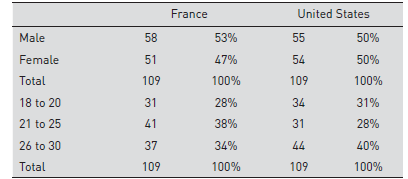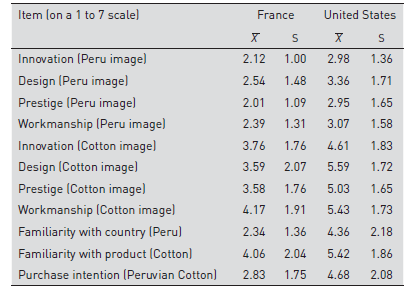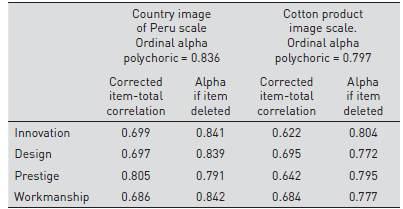1. Introduction
Since pre-Inca times, cotton has been a strategic sector of the regional economy, being one of the most critical agro-industrial crops in Peru and representing the livelihood of 20,000 farming families (Ministry of Agriculture and Irrigation., s.f.; Institute of Economic and Social Studies, 2016). Moreover, cotton is the most used natural fiber in the textile industry (Esteve-Turrillas & de la Guardia, 2017), and cotton quality is one of the critical success factors in the development of textiles (Gyftou, Pavlatou, Spyrellis & Hatz, 2000). Hence, cotton is the main non-food agricultural product with the most extensive international trade in the world (Mallqui, Quispe & Rabanal, 2017). Therefore, in 2005, the Ministry of Foreign Trade and Tourism named Peruvian cotton as a flagship product, in order to contribute to internationalizing Peruvian cotton and textile products of Peruvian cotton (Cadenillas, 2016).
However, the global textile industry is characterized globally by vertical integration within large companies. In consequence, Peruvian cotton producers do not have high bargaining power in the industry (Calderón, Leyva, Miranda & Pais, 2017). Additionally, there is a more competitive environment composed of China, India, the United States, and Pakistan, which have a market share in the international cotton trade of 28%, 12%, 10%, and 7%, respectively (Trade Map, 2016). They intensively invest in research and development, increasing their productivity and reducing costs. Furthermore, Indian cotton is produced from genetically modified seeds, making it more economical than Peruvian cotton (Silva, 2005).
As a result, it is necessary to evaluate the appreciation of Peruvian cotton by international consumers. Recent evidence suggests that it is critical to study the purchase intention since consumers will purchase a specific service or product depending on how they evaluate and appreciate them (Chang & Chen, 2008; Madahi & Sukati, 2012; Huy & Svein, 2012). Additionally, this is useful for estimating sales and demand, choosing target markets, and designing international marketing strategies. Therefore, it is relevant to study the variables that affect or have an association with the purchase intention of Peruvian cotton in the new global economy of cotton textile products. Notably, this paper aims to evaluate international consumers’ purchase intention of Peruvian cotton and derivative products in order to contribute to internationalization and overcome international market pressures of the cotton textile industry.
Most Peruvian cotton export companies do not have a recognizable brand name; therefore, Peru’s country image will have a mediating role in foreign customers’ intent to purchase. According to Bruwer, Buller, Saliba & Li (2014, p. 98), “country image could play the role of a summary variable, meaning consumers use it to summarize information about product attributes”. Hence, the country of origin can affect quality perception and purchase intention (Balabanis & Diamantopoulos, 2004). Notably, products from developing countries such as Peru are supposed to be of inferior quality compared to those from developed countries (Han & Lee, 1994; Amine, Chao & Arnold, 2005). For this reason, this paper will study the country image of Peru and its relation with the purchase intention of Peruvian cotton.
Product image can affect the purchase intention of the consumer since it can affect the evaluation and perception of such a product (Lee & Ganesh, 1999; Roth & Romeo, 1992). Furthermore, product familiarity and country familiarity variables can affect purchase intention; Arvola, Lahteenmaki, and Tourila (1999) demonstrated that a greater product familiarity directly affects the intent to purchase, while Guina and Giraldi (2012) concluded that country familiarity is a variable that can affect consumer purchase intention. Country image is defined as the general perception that people have of a particular country, which is created through functional, emotional and experiential variables (Roth & Romeo, 1992; Papadopoulos & Heslop, 2000).
Similarly, the product image is defined as the general perception related to the production of a specific product from a particular country, which in turn may be dissimilar according to the category under assessment. Notably, product image implies value judgments and will be motivated mainly by functional aspects such as its quality, cost-benefit ratio, and other variables that contribute to generate a country image perception based on the image of its national products (Roth & Romeo, 1992; Papadopoulos & Heslop, 2000; Guina & Giraldi, 2012).
Likewise, the country familiarity variable is conceptualized as the entirety of knowledge and experiences related to a specific country. Both variables determine the degree of impact or relation that an international consumer may have with a particular country. Being composed of experiential aspects, country familiarity will be different for each person, since they will have different perceptions of a specific country (Guina & Giraldi, 2012; Kaynak & Kucukemiroglu, 1992; Urbonavicius, Dikcius & Navickaite, 2011). The originality of this paper is based on the research of the relationship between country familiarity and purchase intention since there is a relative lack of research on the topic. As a result, the purchase intention of an agricultural product from a developing country such as cotton from Peru represents a research gap that this article aims to fill.
The product familiarity variable is defined as all of the knowledge and experience that is created from direct or indirect interaction with the products of a specific country (Guina & Giraldi, 2012; Alba & Hutchinson, 1987; Marks & Olson, 1981; Brucks, 1985; Phau & Suntornnond, 2006). Finally, purchase intention is defined as consumers’ desire to acquire a specific product among other products, which satisfies their needs or the established search criteria, without necessarily translating into the purchase or final behavior of the consumer (Huy & Svein, 2012; Madahi & Sukati, 2012; Khan, Ghauri & Majeed, 2012).
In this context, the general objective is to examine the association between the purchase intention of Peruvian cotton with each of the following variables: country image, product image, country familiarity, and product familiarity. In addition, the specific objectives of the study analyze the association of 1) the country image of Peru with cotton’s product image; 2) the country image of Peru with purchase intentions of Peruvian cotton; 3) cotton’s product image and purchase intentions; 4) familiarity with Peru and purchase intentions of Peruvian cotton; 5) cotton’s product familiarity with purchase intentions of Peruvian cotton, and 6) the effect of Peru’s country image, cotton’s product image, familiarity with Peru and cotton’s product familiarity, with purchase intentions of Peruvian cotton. Consequently, it will be possible to design global marketing strategies for Peruvian cotton export companies and better understand foreign customers’ purchasing decisions.
Correlations were used to analyze the first five hypotheses, and a regression analysis was employed to examine the sixth hypothesis. The data came from two samples: France and the United States. Primarily, survey techniques were used to compile the primary data, adapting Roth and Romeo’s questionnaire (1992). The first part of the paper explains the main theoretical models and findings regarding the relationship between the studied variables and purchase intention. Following this, the hypothesis and theoretical model of purchase intentions of Peruvian cotton are established. Then, the research method and information about the studied samples will be explained, before an analysis of the results, conclusion, and subsequent discussion.
2. Theoretical framework
Roth and Romeo (1992) researched the relationship between country image and product image with the consumer purchase intention and identified four dimensions that shape country image, which are assessed at the same time when the consumer evaluates a different product. Their model helped to decide when it is advisable to promote the product's country of origin and when it is not. The authors suggested that it is advisable to promote country image when it is associated with a positive perception of product image. Therefore, the following hypothesis is stated:
Additionally, Roth and Romeo (1992) concluded that country image is directly associated with the intent to purchase, and the country and product image would positively impact on the purchase intention when there is a positive match between country image dimensions and these dimensions are vital product features. Notably, several global marketing researchers have studied the relation between country image and the intention to purchase. Han (1989) studied the impact of country image on consumer purchase intention, finding that when there is not product knowledge, it can affect purchase intention through the consumer’s perceptions and beliefs.
A similar conclusion was reached by Li, Ahn, Zhou and Wu (2009) who determined that if foreign consumers have a positive country image perception, companies from this country can improve the purchase intention of their products. Li, Yang, Wang, and Lei (2012) found that country image has a positive effect on purchase intention, and Ortiz (2014) showed that country of origin image impacts positively on brand personality, and this interaction has a positive impact on consumers’ purchase intentions. Furthermore, Hong and Wyer (1989), Wang and Yang (2008), Zbib, Wooldridge, Ahmed and Benlian (2010), Khan, Ghauri, and Majeed (2012), and Sinrungtam (2013) found that country image could positively affect the intention to purchase. In consequence, it can be expected that:
H2: the better the country image of Peru is, the greater the purchase intention of Peruvian cotton will be.
Subsequently, Papadopoulos and Heslop (2000) and Lin and Kao (2004) examined Roth and Romero’s model (1992) with different approaches. First, Papadopoulos and Heslop (2000) incorporated a multi-country study, analyzing the impact of the product's country of origin on the consumer’s purchase intention. Second, Lin and Kao (2004) added product brand image to the studied model. Both studies reached similar conclusions to Roth and Romeo (1992) since they found that there is a direct association between both variables, and country of origin impacts positively on the consumer’s intention to purchase.
Other international marketing researchers have continued tostudy country image, as well as product image and its relation to the intent to purchase. For example, Lee and Ganesh (1999) determined that the product brand image and country image positively influence evaluation of the brand. Similarly, Imelia and Ruswanti (2017) concluded that a positive product brand image and country of origin image encourage the intent to purchase. The same results were found by Lin and Chen (2006), who analyzed the effect of the country and product image and found that both variables positively affect consumer purchase intention. Hence, it can be stated that:
H3: the better cotton’s product image is, the greater the purchase intention of Peruvian cotton will be.
Some authors who continue to study the relationship between country image, product image and their relation with the intent to purchase have employed a new research approach; however, they focused on the product and country familiarity effects on such relations. Han (1989) and Arvola, Lahteenmaki and Tourila (1999) found that a greater product familiarity directly affects the intent to purchase. Additionally, Guina and Giraldi (2012) evaluated the influence of country image, country familiarity and product familiarity with purchase intention, and concluded that a greater country and product familiarity positively influence country image, as well as consumer purchase intentions.
Furthermore, Kim, Shin, Cheng, Lennon and Liu (2015) studied the relationship between country familiarity and brand attitude; they found that when consumers become familiar with the country, they form a positive brand attitude; while Han (1990) found that country image is more likely to have a direct impact on the intention to purchase for a brand from a familiar country than for a brand from an unfamiliar country. Similarly, Hwang and Lin (2010), and Liu and Guo (2016) demonstrated that familiarity with a specific culture or country could positively affect consumer purchase intentions. In consequence, the following hypotheses are stated:
H4: the greater the country familiarity with Peru is, the greater the purchase intention of Peruvian cotton will be.
H5: the greater cotton product familiarity is, the greater the purchase intention of Peruvian cotton will be.
According to a theoretical review, several authors such as Lee and Ganesh (1999), Lin and Chen (2006), Arvola et al. (1999) and Guina and Giraldi (2012) found that at least one of the following variables could positively affect consumer purchase intentions: country image, product image, country familiarity, and product familiarity. As a result, it can be expected that:
H6: the country image of Peru, cotton’s product image, country familiarity with Peru, and the cotton’s product familiarity used together have a significant effect on the purchase intention of Peruvian cotton.
According to the theoretical framework, figure 1 shows a diagram of the proposed hypotheses.
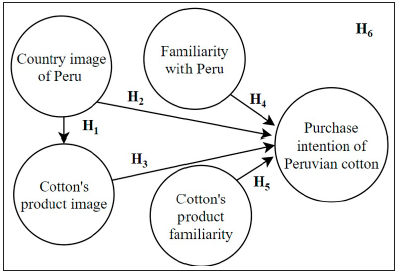 .
.Figure 1 Diagram of the first five hypotheses
3. Method
The nature of this research was correlational and explanatory (Hernandez Sampieri, Fernández Collado & Baptista Lucio, 2006), using the survey technique to gather the primary data through a closed-question questionnaire which was organized into five sections, adapted from Roth and Romeo’s questionnaire (1992). The procedure for selecting countries consisted of identifying and selecting two countries whose inhabitants have a high or low level of familiarity with Peru, depending on their knowledge of Peru from tourist flow between countries, and the main international markets for Peruvian exports (Verbeke & Vackier, 2004).
The United States (US) is one of the leading destination markets for Peruvian exports, representing 15% of total national exports; and its tourists embody 11% of the total visits of international tourists arriving in Peru. In consequence, US citizens have a high familiarity with Peru. The second sample included France, a country whose citizens have low familiarity with Peru: it represents 0.68% of Peruvian exports, and French tourists make up 2% of all the visits of international tourists arriving in Peru (Trade Map, 2017; Superintendencia Nacional de Migraciones, 2017).
Given that the questionnaire was applied to two countries whose native language was different, English was chosen because this language is a mandatory requirement in the universities of such countries. The size of each sample was 109 cases, with a non-probabilistic sampling method used for convenience.
Notably, the statistical research unit was pre-graduate and post-graduate students, since they are more educated, usually have a higher exposure to travel, as well as to the products and cultural aspects of other countries, and therefore have greater product familiarity and country familiarity. Such a familiarity level of the samples allowed the carrying out of the evaluation between Peruvian cotton and cotton from other countries in the survey and provided more generalizable results (Roth & Romeo, 1992). Similarly, the students were of both sexes because the purchase of cotton is not attributed to people of any particular gender.
A self-administered questionnaire technique was used to survey the selected samples; additionally, a pilot test was conducted for 50 people in total, from both countries, to evaluate the effectiveness and understanding of the questionnaire, as well as the disposition of the questions and answers and the reliability of the variables used. Hence, the wording and understanding of the questionnaire were improved. Peru’s country image and cotton’s product image variables were measured using a single scale with four identical items (Innovation, Design, Prestige, and Workmanship) based on Roth and Romeo´s model (1992).
Additionally, the interval method and semantic differential scale were used to measure the response categories, with responses organized on a seven-point scale (from 1 to 7). Country familiarity, product familiarity, and consumer purchase intention variables were measured using a single item, and a semantic differential scale from 1 to 7, following the guidelines of Roth and Romeo’s model (1992). In particular, the semantic differential scale was used due to its simplicity when using administered questionnaires, and the speed in tabulating the information. Kinnear and Tailor (1999) also suggest using the semantic differential scale in marketing research for its ease of application.
4. Results
This part is organized into two sections, and the first one shows the preliminary analysis of the samples, reliability results for the multi-item scales, dimensionality results and component matrix for country image scale and cotton product image scale. The second section shows the results and a brief analysis of each hypothesis.
4.1 Preliminary analysis
Table 1 shows the gender and age distribution across the samples. No significant association was found between gender and country (X2=0.165; p=0.684). Concerning the variable age, the homoscedasticity test presented no significant differences (Levene F=1.487; p=0.224). The t-test for independent samples also found no significant differences between both means (t=-1.102; p=0.272).
Descriptive statistics of researched variables are shown in table 2.
In order to verify assumptions about Peru’s country familiarity variable, a t-test of comparison of means was performed for this variable. A value t=+8.187 (p =0.000) was obtained. This confirms the initial assumption that the USA sample has a Peru country familiarity significantly greater than the French sample. In order to observe the statistical reliability for Peru’s country image and cotton’s product image scales (table 3), ordinal alpha polychoric was calculated, particularly, it was used two criteria’s to confirm the reliability of the scales: (i) ordinal alpha polychoric greater than 0.7 and (ii) item-total correlations greater than 0.4. The values of both statistics satisfied both criteria’s.
Tables 4 shows the dimensionality results for country image and product image variables; the variance explained by the first factor is higher than 50% for both. This first factor represents the unique one that has an eigenvalue higher than one. Moreover, the variance explained by the second factor is not much greater than that explained by the third factor. Table 5 shows items’ factor loadings in the first factor. They all are higher than 0.80 and reach their maximum value in this first factor; hence, it is evidence that the country image and product image are one-dimensional variables (Carmines & Zeller, 1979).
Table 4 Dimensionality results for country image scale and cotton product image scale.
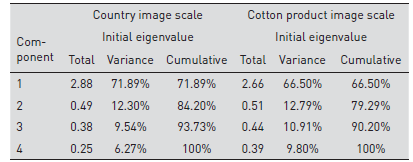
Source: own elaboration.
Table 5 Component matrix for country image scale and cotton product image scale (1 component extracted).
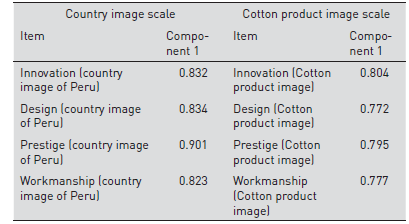
Source: own elaboration.
4.2. Study of the hypothesis
Relative to the study of H1, table 6 shows that Peru’s country image is not significantly associated with cotton’s product image in the French sample (r=+0.133; p=0.168). In contrast, such an association is significant and positive in the US sample (r=+0.261; p=0.006). Therefore, Peru’s country image is directly associated with cotton’s product image when the foreign consumer has a high level of familiarity with Peru.
Subsequently, the results of H2 show that Peru’s country image is significantly and directly associated with the purchase intentions of Peruvian cotton, in the French sample (r=+0.258; p=0.007) as well as in the US sample (r=+0.362; p=0.000) (table 7 ). Hence, Peru’s country image is positively associated with purchase intentions of Peruvian cotton whether the foreign consumer has a high or low level of familiarity with Peru.
Concerning H3, table 8 shows that cotton’s product image variable is not significantly related to the purchase intention of Peruvian cotton in the French sample (r=+0.157; p=0.103). However, it is significant and positive in the case of the US sample (r=+0.103; p=0.000): cotton’s product image is directly associated with the purchase intention of Peruvian cotton, only when the foreign consumer has a high level of familiarity with Peru.
Similarly, the results of H4 indicate that the correlation between country familiarity with Peru and the purchase intention of Peruvian cotton is significant and direct, in the French sample (r=+0.234; p=0.014) as in the case of the US sample (r=+0.338; p=0.000). In consequence, country familiarity with Peru is directly associated with the purchase intention of Peruvian cotton, when the foreign consumer has high or low level of familiarity with Peru (table 9).
According to the results of H5, the association between cotton product familiarity and purchase intention of Peruvian cotton is significant and direct, in the French sample (r=+0.161; p=0.094), and the US sample (r=+0.538; p=0.000).
As a result, cotton product familiarity is significantly associated with purchase intention of Peruvian cotton, for foreign consumers with a low or high level of familiarity with Peru (table 10).
To test H6, the following regression equation was formulated:
Where:
β 1=Regression coefficient of cotton product familiarity ,
β 2= Regression coefficient of country familiarity with Peru,
β 3= Regression coefficient of country image of Peru,
β 4= Regression coefficient of cotton product image.
The regression equation shows that the dependent variable is the purchase intention of Peruvian cotton, and the independent variables are 1) cotton’s product familiarity, 2) country familiarity with Peru, 3) Peru’s country image, and 4) cotton’s product image. These variables have a quantitative nature; therefore intro method was used to regression analysis. Its purpose was to identify which independent variables are significant to explain purchase intention of Peruvian cotton. It defines the null hypothesis Ho: β1=β2=β3=β4=0.
Before carrying out the regression analysis, multicollinearity and presence of outliers were examined through several tests. As a result, the studied models did not present extreme cases or multicollinearity issues in any of the samples. In the French sample, R2 corrected was 0.106, and variance explained by the regression model was significant (F=4.186; p=0.003). In consequence, the null hypothesis (Ho: β1=β2=β3=β4=0) is not accepted in the French sample.
This means that not all beta coefficients of the regression model are zero. Regression coefficients indicate that in the French sample null hypothesis is not accepted for Peru’s country image (B3=0.120; p=0.011): this is a significant variable to explain purchase intention of Peruvian cotton. This relation is direct since it was found that β3> 0. In contrast, cotton product familiarity (B1=0.110; p=0.204), familiarity with Peru (B2=0.236; p=0.052) and cotton product image (B4=0.024; p=0.434) are not significant variables to explain purchase intention of Peruvian cotton. Hence, it is concluded that β1=0, β2=0, and β4=0 (table 11).
Table 11 Significance of the regression coefficients for the purchase intention of Peruvian cotton (French sample).
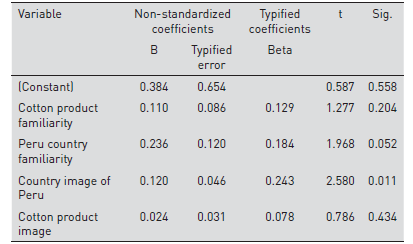
Source: own elaboration.
On the other hand, US sample regression results show that R2 corrected is 0.358, and the explanatory variables significantly explain the purchase intention of Peruvian cotton (F=16.051; p=0.000). As a result, the null hypothesis is not accepted (Ho: β1=β2=β3=β4=0); all beta coefficients of the regression model are not zero. Regression coefficients indicate that in the US sample, the null hypothesis is not accepted for cotton’s product familiarity variable (B1=0.442; p=0.000) and cotton’s product image (B4=0.081; p=0.015).
As a result, it can be seen that such variables significantly affect the purchase intention of Peruvian cotton. This relation is direct given that β1> 0 and β4> 0. In contrast, familiarity with Peru (B2=0.069; p=0.459) and country image of Peru (B3=0.063; p=0.088) are not significant variables to explain purchase intentions of Peruvian cotton. It is concluded that β2=0 and β3=0 (table 12).
Table 12 Significance of the regression coefficients for the purchase intention of the Peruvian cotton (US Sample).
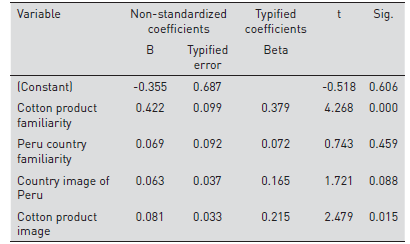
Source: own elaboration.
There are notable differences between the significant variables and those that are not significant, from one sample to the other. Thus, when the four variables are analyzed together to explain the purchase intention of Peruvian cotton, it was found that the country image of Peru (p=0,011) is significant at a 5% level of significance in the French sample, and at a 10% level of significance (p=0,088) in the U.S. sample. Therefore, the country image of Peru can explain the purchase intention of Peruvian cotton in both samples.
5. Conclusions
H1 (the better the country image of Peru is, the better cotton's product image is) should be accepted in cases when the foreign consumer has a high level of familiarity with Peru, and it should not be accepted for the cases when familiarity is low. It means that when the studied sample has a high level of familiarity with Peru, they have a positive perception of Peru and cotton from Peru (Lee & Ganesh, 1999; Roth & Romeo, 1992). However, Roth and Romeo (1992) concluded to the contrary that the level of country familiarity does not affect image perceptions. This study suggests that the level of country familiarity works as a moderator variable between country image and product image. The practical implication is that Peruvian cotton exporters could innovate their global marketing strategies using the country image of Peru to improve cotton product image positioning, especially for American consumers or markets with a high level of familiarity with Peru.
Regarding H2 (the better the country image of Peru is, the higher the purchase intention of Peruvian cotton will be), it should be widely accepted, in cases when the foreign consumer has a low or high level of familiarity with Peru. Such a result is coherent as found in H6, since when the four variables were studied together to explain purchase intention, it was found that the country image of Peru was significant in both samples. In consequence, the country image of Peru can be the main factor to stimulate the purchase intention of Peruvian cotton in markets with a high or low level of familiarity with Peru. Hence, foreign consumers could perceive that Peru can produce high-quality cotton in comparison with other countries.
The theoretical implication of such a finding is that it would seem that international consumers perceive that a developing country such as Peru can produce an agricultural product such as cotton with positive attributes like high-quality. This possible conclusion is different from that proposed by Balabanis and Diamantopoulos (2004) who suggested that products from developing countries such as Peru are supposed to be of inferior quality relative to those from developed countries. This could be mistaken if the developing country produces agricultural products since they can be well-perceived by international consumers like Peruvian cotton.
The practical implication is that companies exporting cotton from Peru could use Peru’s country brand as an umbrella brand to export their products, and use it in international fairs, web pages, data sheets and other strategic information that highlights the cotton’s country of origin. The country image could be used in global marketing strategies for agricultural products from developing countries to encourage purchase intentions of international consumers.
H3 (the better cotton’s product image is, the higher the purchase intention of Peruvian cotton will be) should be accepted in cases when the foreign consumer has a high level of familiarity with Peru; in contrast to when the level of familiarity with Peru is low. Such a result is different from that found by Roth and Romeo (1992), who postulated that familiarity differences do not affect the relation between product image and purchase intention. Furthermore, according to H6, cotton product image positively influences the purchase intention of Peruvian cotton only when the consumer has a high level of familiarity with Peru.
The results may indicate that the level of familiarity with Peru can contribute to shaping consumer perceptions about cotton’s product image and its evaluation, meaning that familiarity differences affect the relation between product image and purchase intention. Hence, the level of country familiarity could work as a moderator variable between the product image and purchase intention. Two possible marketing applications are that Peruvian cotton exporters could 1) reposition cotton’s image as a high-quality product, highlighting its attributes such as fiber length, strength, elongation, brightness, and others; and 2) use cotton’s product image ingeniously through promotion policies, online campaigns, websites, trade fairs, and others, in the United States or markets with a high level of familiarity with Peru.
As regards to H4 (the better the country familiarity with Peru variable is, the higher the purchase intention of Peruvian cotton will be), it has been concluded that there is a full acceptance of it, in cases when the foreign consumer has a high or low level of familiarity with Peru. However, according to H6, country familiarity with Peru positively affects the purchase intention of Peruvian cotton only when the consumer has a low level of familiarity with Peru. In consequence, the level of country familiarity with Peru can predict the purchase intention of Peruvian cotton only when the consumer has a low level of familiarity with Peru.
This finding is comparable and similar to that found by Guina and Giraldi (2012) who concluded that a greater level of product familiarity is positively related to consumer purchase intention. However, this study demonstrated that this is true particularly when the consumer has a low level of familiarity with the country of origin of such a product. A possible explanation is that if the consumers have a high level of familiarity with Peru and they increase their knowledge or experiences relative to Peru or develop more country familiarity with Peru, their purchase intention of Peruvian cotton could not increase since they are already familiar with the country. Hence, country familiarity does not have explanatory power when the consumers are already familiar with the country in question.
The practical implication is that Peruvian cotton exporters should focus their sales and marketing strategies on American consumers since they are more familiar with Peru; hence, the costs of educating consumers about Peru are lower than in the French market. However, if they have the budget to educate consumers from France or other countries with less country familiarity, they could create marketing strategies to educate them about Peruvian history, local Peruvian producers of cotton, and other information about Peru.
Relative to H5 (the better cotton product familiarity is, the higher the purchase intention of Peruvian cotton will be), it should be accepted in cases where the foreign consumer has a high or low level of familiarity with Peru. However, according to H6, cotton product familiarity positively affects the purchase intention of Peruvian cotton only when the consumer has a high level of familiarity with Peru. In consequence, the level of cotton product familiarity can predict the purchase intention of Peruvian cotton when the consumer has a high level of familiarity with Peru. Both findings are complementary since H5 was accepted in the French sample at a 10% level of significance and in the American sample at 5%. This means that cotton product familiarity cannot be the primary variable to foster the purchase intention of Peruvian cotton when the international consumer has a low level of familiarity with Peru. Authors such as Han (1989), Arvola et al. (1999) and Guina and Giraldi (2012) concluded remarkable results; furthermore they suggested that product familiarity is a crucial variable to achieve a positive evaluation and stimulate consumer purchase intentions. However, this study has demonstrated that product familiarity is a crucial variable mainly when the consumer has a high level of familiarity with the country of origin of the product. A possible explanation is that consumers with a high level of familiarity with Peru are more educated to purchase a product that comes from Peru; hence, the product image is more favorably perceived and the intention to purchase it. The practical recommendation is that Peruvian cotton exporters could modernize their marketing strategies by educating consumers about the properties, attributes, and benefits of Peruvian cotton in order to encourage their purchase intention, especially when the target market has a high level of familiarity with Peru.
When the four variables were studied together to explain purchase intention, it was found that the country image of Peru is a significant factor, in both samples. Hence, there is not enough evidence to accept H6 (the country image of Peru, cotton’s product image, country familiarity with Peru, and the cotton’s product familiarity used together have a significant effect on the purchase intention of Peruvian cotton). However, Peru’s country image positively affects the purchase intention of Peruvian cotton in both samples. As mentioned previously, this finding can be complemented by the full acceptance of H2 (the better the country image of Peru is, the higher the purchase intention of Peruvian cotton will be). Similarly, each regression variable was studied via correlational analysis, and both studies are complementary to better understand the behavior of studied variables.
As a result, the relationships between Peru’s country image, cotton’s product image, country familiarity with Peru and cotton’s product familiarity with the purchase intention of Peruvian cotton are heterogeneous along with both samples. Hence, the level of familiarity is a moderator variable in such relationships, and global marketing strategies should be adapted to the market based on the level of familiarity.
One of the leading research limitations was the non-probabilistic sampling method, restricting the conclusions to the examined samples. Additionally, given that the size of the sample was small, the consumer's purchase intention according to gender, age, and socioeconomic level of the consumers studied was not analyzed. Another research limitation was using multidimensional constructs only for country image and product image variables, while the others were unidimensional; hence, it is suggested that future researchers might design multidimensional constructs for the studied variables using structural equations to test the model.
